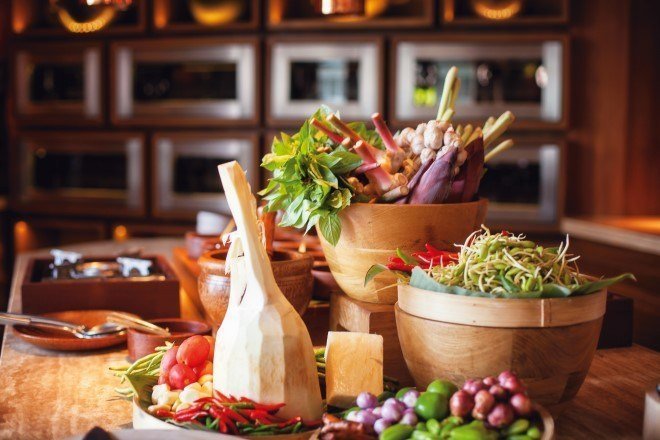Thai Food Culture Sharing Is Giving In Asian Food Culture
Credits: The Tourist Authority of Thailand
Discover Thailand with Thailand Discovery
Thai food culture sharing. Thai food defies most culinary definitions. For Thais, it is more than a cuisine but a lifelong passion. It is a love affair with deep sociological roots which tie it to the country’s culture and most importantly to family. Every extended Thai family is a hive of foodies, from parents going to the market or cooking family meals, to extended family members bringing home snacks and sweets as gifts after every social outing or domestic sojourn.
Over several decades, Thai cooking schools have promoted the national cuisine, both in Thailand and overseas. You are just as likely to find cooking classes and Thai food specialty markets in San Francisco and London now as you are in Bangkok. This infrastructure plays an important role in educating foreigners on how to best enjoy Thai cuisine, in addition to enticing them to hopefully learn how to cook it at home to eat with family and friends.
Shared Servings
Sharing communal dishes is common throughout Asian food culture, particularly with Thai food. Thai people place great attention on dining etiquette which requires diners to be refined and gentle in their manner as they eat, and share dishes with friends and family.
At restaurants, several dishes are ordered including appetisers, salads, stir fries, barbecued meat or fish and soup. Soup is individually portioned, but the rest of the meal is usually shared with each diner taking small single bite portions using either a serving spoon or more often than not with their own cutlery. Non-Thais who refer to this practice as ‘double dipping’ should rethink dining etiquette when eating Thai food.
Food sharing in Thai culture is a form of giving, one that shouldn’t be interrupted when someone else’s spoon returns to the same dish.
Rice Canvas

Thai Food Culture Sharing
Quality long grain rice (Thai Jasmine Rice is preferred) serves as the foundation for great Thai cuisine. Thais and other Asian cultures often view it as a ‘canvas’ to paint on with food. Individual single bite portions are spooned over rice to separate one dish, one flavour from another.
The philosophy behind Thai dining is to balance the flavours – sour, sweet, salty or bitter in one meal, not to saturate one’s rice place with one dish because then you can’t taste the next one. To grab a bowl of ‘Thai Green Curry’ and ladle it over the centre of your rice plate, then repeated with ‘Fried Morning Glory in Oyster Sauce’ and ‘Tom Yum Kung’ soup is not just bad form; it destroys the delicate flavour balance of each dish.
So, it is best to embrace shared servings (and double dipping) while keeping one’s rice canvas pristine during communal meals; these are important guidelines to maintain dining etiquette and ensure maximum enjoyment when eating Thai food.
Eat Street

Thai Food Culture Sharing
Visiting Thailand makes it easy to sample unique dishes found around the country as Thai food varies greatly from region to region. Thai street food has a wide range of tasty offerings and a chance for a quick education of regional favourites. Visitors can quickly get acclimated to various choices on offer by tucking into Bangkok’s vibrant and diverse street food scene.
Always make sure to frequent venues or street enclaves patronised by local Thais, not tourists. These include but are not limited to Yaowarat, Silom Road, Bangrak, Khao San Road and the Banglumphu area, to name just a few of the more popular spots.
Cooking Classes

Thai Food Culture Sharing
Becoming street wise often helps make it easier to learn how to cook Thai food. It is wise to hone in on a favourite regional cuisine as most cooking schools offer classes focusing on food found in the region where they’re based.
Some of the most popular cooking schools in Thailand include MSC Thai Culinary School, Bangkok (run by Chef Chumpol); Thai Farm Cooking School, Chiang Mai; Phuket Thai Cooker and Brass Wok Cooking School in Phuket; Amita Thai Cooking Class (Home Cooking) and the Oriental Thai Cooking School (Art of Thai Delicacy).
Regional delicacies

Thai Food Culture Sharing
Thai food has long been influenced by neighbouring countries, their culinary cultures and visitors to the Kingdom. Dishes from Thailand’s central region have hints of Indian and Persian flavours, while northern cuisine from around Chiang Mai province takes inspiration from neighbouring regions like Tai Yai, Southern China. Southern Thai cuisine has a distinct Muslim flavour while Thailand’s northeast region (Isan) produces fiery and pungent dishes that are very much Laotian in character.
So keep checking the TAT Newsroom’s Features section for upcoming articles on Thai dishes and cooking styles indigenous to each of the major four regions of Thailand.
For high-resolution images, please click to visit the TAT Newsroom Photo Library – Food, Fruits & Herbs: Thai food.
[wp-review id=””]

Visitor Rating: 5 Stars
Visitor Rating: 5 Stars
Visitor Rating: 5 Stars
Visitor Rating: 5 Stars
Visitor Rating: 5 Stars
Visitor Rating: 5 Stars
Visitor Rating: 5 Stars
Visitor Rating: 5 Stars
Visitor Rating: 5 Stars